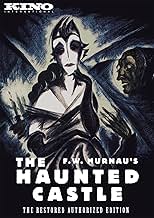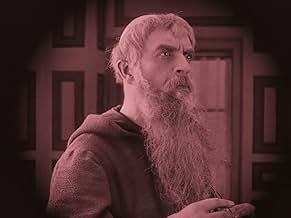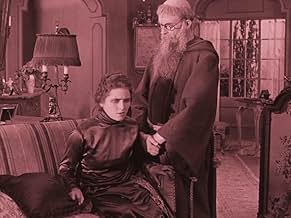In the castle Vogeloed, a few aristocrats are awaiting baroness Safferstätt. But first count Oetsch invites himself.. Everyone thinks he murdered his brother, baroness Safferstat's first hus... Read allIn the castle Vogeloed, a few aristocrats are awaiting baroness Safferstätt. But first count Oetsch invites himself.. Everyone thinks he murdered his brother, baroness Safferstat's first husband, three years ago. So he is rather undesirable. But Oetsch stays; arguing he is not th... Read allIn the castle Vogeloed, a few aristocrats are awaiting baroness Safferstätt. But first count Oetsch invites himself.. Everyone thinks he murdered his brother, baroness Safferstat's first husband, three years ago. So he is rather undesirable. But Oetsch stays; arguing he is not the murderer and will find the real one...
- Centa V. Vogelschrey - von Vogelschrey's Frau
- (as L. Kyser-Korff)
- Graf Johann Oetsch
- (as Lotar Mehnert)
- Der Pater Faramund
- (as Victor Blütner)
- Ein Diener
- (as Walter Kurt-Kuhle)
- Kleines Mädchen
- (uncredited)
- Zweites Kleines Mädchen
- (uncredited)
- Küchenjunge
- (uncredited)
- Director
- Writers
- All cast & crew
- Production, box office & more at IMDbPro
Featured reviews
** 1/2 (out of 4)
An "old dark house" film from director F.W. Murnau about a group of people staying in an (what else?) old dark house. One night the house's owner turns up missing and later in the night his son, who was accused of killing his own brother, shows up. I read somewhere that this is the earliest surviving work from director Murnau but this here doesn't show any of his wonderful visual style that would kick into high gear the following year with Nosferatu. The film, running just under an hour, takes way too time introducing us to the characters and the actual mystery doesn't start until the very end of the movie. There really isn't any visual style either. There's one character that looks like the Karloff character in Whale's The Old Dark House, which makes you think Whale saw this film (especially since the character here leads to a good twist in the story). Another interesting aspect is a scene that uses the hands of Nosferatu to a similar effect that would be seen in the next year's Nosferatu. I had to view an overly dark, 16mm print without a music score.
Murnau demonstrates his superb command of the camera and the illumination while setting the bases of the expressionism.
The suspense distilled in Haunted Castle is well worth a Hitchcock´s movie and the plot is surprisingly complex for a silent.
Do make sure that you see it in a winter stormy night
My expectations were a bit high for this, based on the title and the director, and I was disappointed that this ended up not being a horror film at all. The acting is fairly typical, if at times overheated, and the story is a bit dull and drawn out, even with a brief ~70 minute running time. The castle set is nice, but there are none of the typical Murnau touches that make things stick in one's memory.
Lothar Mehnert stars as Count Oetsch, and although I know absolutely nothing about him, I was very drawn to his performance. He has a striking look that I think makes for a good stage or screen presence. What else has he done? I do not know, but should seek it out.
The film is light on humor, though there is a sequence I will call "the kitchen boy dream" that I found funny. What is it implying? What does it mean? How does it connect to the big story? I have no idea.
The Kino DVD contains a book / film comparison and I would recommend this. It shows how radically different the film is in some ways from the book. While the essence is the same, I would almost have to say they are two different creatures altogether.
This is an early offering in F.W. Murnau's film-making career, and none of the brilliance of his later films ("Nosferatu", "The Last Laugh", "Faust", "Sunrise") is evident here. "The Haunted Castle" is prosaically filmed, despite the assistance of two competent cinematographers, László Schäffer ("Berlin: Symphony of a Great City") and Fritz Arno Wagner ("Nosferatu" and several of Fritz Lang and G.W. Pabst's films). Additionally, Hermann Warm ("Caligari") was the production designer. The castle interiors are rather rich, at least. But, the miniature used for the exterior views of the castle, as a transition effect, is overused and ineffective. I don't care for the iris openings and closings, either; they're usually too obtrusive for transition editing.
Anyhow, there were some surprises in the plot for me, but that didn't make it worthwhile. Despite having another giant of Weimar cinema, Carl Mayer ("Caligari", "The Last Laugh"), as one of the screenwriters, the plot is slow-paced and never evolves to anything higher than a whodunit--and not even a good one at that. The acting is too obvious and overdone, as well. The talent involved did much better work elsewhere.
Did you know
- TriviaThe movie was shot in 16 days and released before the serialized novel's last chapter had been printed in the "Berliner Illustrierten".
- Alternate versionsThere is an Italian DVD edition of this movie, distributed by DNA Srl, entitled "Il castello di Vogelod". The movie was re-edited with the contribution of the film history scholar Riccardo Cusin. This version is also available in streaming on some platforms. This DVD also contains another movie directed by F.W. Murnau: "Tartufo".
- ConnectionsFeatured in Dämonische Leinwand - Der deutsche Film der zwanziger Jahre (1998)
- How long is The Haunted Castle?Powered by Alexa
Details
- Runtime1 hour 15 minutes
- Sound mix
- Aspect ratio
- 1.33 : 1
Contribute to this page





























